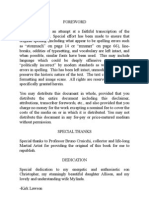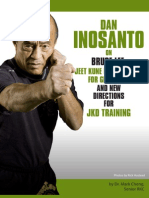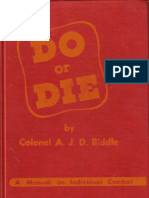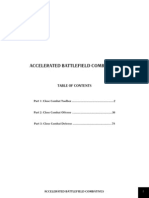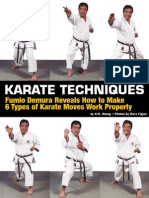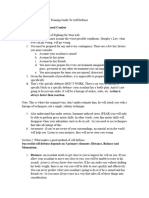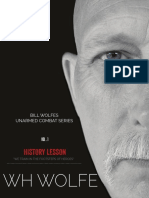Guia
Guia
Uploaded by
Laohu WuxiaCopyright:
Available Formats
Guia
Guia
Uploaded by
Laohu WuxiaOriginal Description:
Original Title
Copyright
Available Formats
Share this document
Did you find this document useful?
Is this content inappropriate?
Copyright:
Available Formats
Guia
Guia
Uploaded by
Laohu WuxiaCopyright:
Available Formats
Kelly McCanns Essential Self-Defense Moves for Winning Real Street Fights
Photography by Thomas Sanders
by Robert W. Young
-ops community or ce rtain at youll ever meet him, let alone pick his brai for fighting secrets s n ince he doesnt train th e public. Fortunately, yo u can benefit from hi knowledge and experienc s e because Black Belt ha s developed an ongoing relationship with him. Heres the short ve rsion of his curriculu m vitae. He is a former U.S. Marine special-missions office r responsible for coun terterrorism and counte r-narcotics. He now serves as pres ident of Crucible, a fir m that organizes prot ective details in all sorts of high-risk envir onments, provides sec urity support services a nd trains military, government and law-en forcement operators to do whatever it takes to survive and complete their mission . He has taught comb atives and other special -ops skill sets for more than 25 years. H is clients include the U .S. Department of Defe nse, as well as various other U.S. gover nment agencies and spec ial-mission units. He an d his team have operated and provided t raining in more than 30 countries. The duties and serv ices McCann has rend ered over the years reve al his specializations in the field of fighting: the development and im plementation of numero us concealed-weapons courses, combative-sk ills curricula and stree t-crime avoidance prog rams. Hes also served as a subject-matter exp ert in close-quarters combat, high-risk prot ective services, highrisk-environment force p rotection tactics, and terrorist techniques an d procedures. A former military and sec urity analyst for CNN and MSNBC, he can no w be seen on Fox New Since 1993, McCann s. has operated Crucible, an elite empty-hand an d weapons training facility located in Fred ericksburg, Virginia. (P sst ... dont bother vyi ng for a spot in one of its high-demand co urses unless youre a police officer or mem ber of the military. They dont take civilians .) other government agenc ies, chances are slim th Editor
encounter. Scratch th
Kelly McCann is one o
at. If youre not part
f the most experienced
of the military special
real-world fighters you
re likely to
DISCLAIMER
BLACK BELT COMMUNICATIONS, an Active Interest Media Publication, as publisher, does not endorse and makes no representation, warranty or guarantee concerning the safety or effectiveness of either the products and services advertised in this magazine or the martial arts or other techniques discussed or illustrated in this document. The publisher expressly disclaims any and all liability relating to the manufacture, sale or use of such products and services and the application of the techniques discussed or illustrated in this document. The purchase or use of some of the products, services or techniques advertised or discussed in this document may be illegal in some areas of the United States or other countries. Therefore, you should check federal, state, and local laws prior to your purchase or use of these products, services or techniques. The publisher makes no representation or warranty concerning the legality of the purchase or use of these products, services and techniques in the United States or elsewhere. Because of the nature of some of the products, services and techniques advertised or discussed in this document, you should consult a physician before using these products or services or applying these techniques. Specific self-defense responses illustrated in this document may not be justified in any particular situation in view of all of the circumstances or under applicable federal, state or local law. Neither Black Belt Communications nor the author makes any representation or warranty regarding the legality or appropriateness of any technique mentioned or depicted in this document. You may be injured if you apply or train in the techniques illustrated in this document and neither Black Belt Communications nor the author is responsible for any such injury that may result. It is essential that you consult a physician regarding whether or not to attempt any technique described in this document.
BLACK BELT
blackbeltmag.com
Whats your opinion of the material thats being taught in the civilian self-defense community? I really dont have much to do with the civilian self-defense community, but it seems that there are far more armchair instructors than there are instructors who have a personal relationship with real violence. Thats apparent from some of the DVDs and videos Ive seen. The techniques are way too segmented, way too defensively focused pretty impractical. There are two problems with that. One, the armchair instructor doesnt understand how the body dysfunctions in a potentially lethal encounter or what you can expect your body to reasonably be able to do. Two, it means students who pursue self-defense from an armchair instructor often dont understand that theres not a painless way to learn because you have to be put under duress in training to do it. You have to have a technique done to you in order to feel the effectiveness, and you have to do it to others to see that you can achieve an acceptable result. There are, of course, a lot of well-intentioned teachers; they simply lack experience with violence. There are also a lot of students who see training as more of a social event. To overcome that obstacle, must a student of self-defense seek out a teacher who has firsthand experience with violence, or is it sufficient to study under a teacher whos studied under someone whos experienced it? You can learn from someone whos been properly trained but who doesnt have firsthand experience. Its critical that your instructor understands what the physiological effects of imminent danger are and how those effects diminish response ability, as well as how street violence occurs. The problem is, in the martial arts, a student usually has a subordinate position with respect to his instructor, and the student should never question the instructor. You cant ask, Who are you and why should I listen to you? Unfortunately, there are a lot of charlatans who can look the part
to a newbie. The second part of the solution is for the student to personally embark on a journey to understand what real violence is, how quickly it happens and under what conditions including how a human being reacts under duress. Theres a ton of literature about what you can and cant do when you suffer tunnel vision, auditory exclusion and physical dysfunctions. After that, the student needs to find an instructor who will put him in those positions in training so he has to defend himself under duress using sensory overloading, stressors, etc. Then the student will learn whether he really needs a right-hand technique, a left-hand technique and a two-hand technique or just one technique that handles all those variables, which is what we believe. Choice reaction time should be minimized to increase the likelihood of success on the street. What aspect of civilian self-defense needs more emphasis? You need to learn equally about when youll be expected to fight and how youll be expected to fight. You might be able to do a certain technique every time in a safe environment and then completely fail on the street in an unfamiliar environment [because youre] under duress and in a compressed time cycle. Is too much time spent on empty-hand self-defense and not enough on weapons defense? Theres a liability issue related to that choice for instructors who deal routinely with the public, and rightfully so. In our litigious society, people might be able to come back on an instructor who reasonably and accurately taught techniques before putting the responsibility on the student to perfect those techniques and judge when to use them. A guy learns how to take away a weapon on Thursday and then tries to do it on Sunday outside a restaurant during a street robbery and gets shot. Now hes crippled. Hes suing his instructor. Thats not a concern for the
IMMINENT ATTACK: Kelly McCann (left) assumes a nonthreatening guard position when he is confronted by a threatening stranger (1). He visualizes striking the assailant before the man can attack him, then executes a stop-hit face mash as soon as he detects increased physical aggression (2). To create the correct hand shape, McCann orients his fingers as if hes holding a softball. The movement is executed by vaulting forward off the rear foot, thus propelling the hand into the opponents face. McCann doesnt step forward and pull his weight, nor does he strike with his arm. Rather, he uses his whole body for power.
3 BLACK BELT blackbeltmag.com
ONE-HAND GRAB: The assailant grasps Kelly McCanns shirt and begins pushing him backward (1). As soon as his intent to punch is clear, McCann attacks the gripping appendage with a hand hook; he doesnt grab it (2). He then pivots on his right foot and violently moves his shoulder and hip rearward around the pivot point, jerking the man forward and disrupting his balance. At the same time, he strikes downward into the crook of his arm. The explosive blow relies on off-balancing, pain avoidance and pressure to put the thug on the groundall while McCann maintains the hand hook (3). As the opponent falls, McCann continues to open the gate by pivoting out of the way as he moves his striking hand to support his gripping hand (4). Without bending down, McCann extends the trapped limb and uses the inside of his thigh to hyperextend the elbow while keeping his weight on the knee thats trapping the mans head. Meanwhile, he collapses his right knee against the assailants back as he chambers his right hand for a strike (5). McCann then unleashes blows as necessary without aiming for specific targets (6). Face strikes are avoided because they would require him to bend too far forward and thus risk being pulled down.
4 BLACK BELT blackbeltmag.com
students we train because they know theyre far more likely to face those eventualities and have accepted the inherent risks involved in their jobs. It behooves them to get proficient at weapons techniques. Is that why military instructors readily teach soldiers how to disarm a gunman, while most civilian instructors say, Just give him your wallet? Yes, and by the way, you should give him your wallet. If the soldier is on leave and confronted by [an armed assailant who wants] his wallet, he should give it up, too! Your wallet, your watch no material possession is worth dying for. The problem is when the potentially violent encounter becomes about something else and your life is in danger. In our clients world of work, the situations in which they would disarm someone have nothing to do with a robbery and everything to do with duty responsibility; that responsibility doesnt [apply] to the public. What kind of weapons should martial artists carry for selfdefense, and what should they have at home? The legal ones. Make sure you meet all your states legal requirements before getting or carrying a weapon. OC gas (pepper spray) is great to carry because its a distance weapon. You can use it early in an altercation, before you even make contact with the assailant, and not a lot of technique is required. When its legal, an expandable baton is also great because it gives you distance. Its basically a stick, and everybody can use a stick with some degree of success. In states where the expandable baton is illegal, like California, is there a legal option thats just as good? The pocket stick also known as the yawara or kubotan is good if you have the skills to use it, but its not quite as effective as the expandable baton because you have to close with your attacker. Knives are certainly good if youve got the guts to use one. A sharp instrument is a great weapon; trouble is, its use is generally viewed as felonious. If you ever use a knife in self-defense, youll probably get killed in court. The opposing attorneys will undoubtedly say a higher standard applies because youve been trained and that you should have tried to ... blah, blah, blah. Thats why OC gas and pocket sticks are better weapons for those who know how to use them. What about in the home? Are guns the answer? Yes, and dogs. At home, you want layered security. You want to affect the thinking the decision-making process and victim selection of anyone who may be looking at breaking in. You want to make him think youre a hard target. For the first layer, you should have good lights around your house and good locks. If someone breaks in, the second layer is a dog. For the third layer, OC gas and maybe a gun with the caveat that you have to be properly trained in combative shooting while under duress. A gun is good only if youll use it and know when to use it. You also need to consider who else is in the home, who has access to the gun, and what safety measures need to be in place to protect it from theft and/or unauthorized use by a child. The thing with guns is, a person may be a good shot, but that doesnt matter if he second-guesses himself right up to the last minute and doesnt shoot until its too late. For that kind of
person, OC gas is a better option. Whats the value of improvised weapons? How can a person train to use them? An improvised weapon is a mentality, not a tool. In other words, if you have the improvisational mentality, it doesnt matter whats at hand. You can use a pen to stab. You can fold a credit card and use it to cut a guys face. You can grab a soda can and rip it in half and youll have two knives. Even a videocassette, slung into a guys throat, can be more effective, and quicker, than an empty-hand technique. How do you teach that mentality? You show your students how its done by using a lot of examples, after which you teach the principles: how to create leverage, how to inflict pain, how to cut, how to see the weapon attributes in ordinary things. What are the best martial arts for students interested in reality-based self-defense? The Philippine arts are one of the best choices because theyre just so dirty in a good way and utilitarian, and theyre great for developing hand speed. When it comes to striking, krav maga has come a long way. It used to be just bad jujitsu if you look at the book Fighting Fit by Col. David Ben-Asher of the Israeli Defense Force, you can see that but its evolved into a very good striking system. Did krav maga evolve here or in Israel? It evolved here. Its remarkable. I was a krav maga member in the early 80s because I wanted to see what it was about. I wasnt that impressed. Now its a fierce striking art. I also like some of the karate styles that are short on philosophy and religion and long on strength, power and short, linear movements. Same with some of the Korean styles that focus on power strikes. Actually, any martial art thats boiled down to its essentials will do. Unfortunately, instructors feel compelled to make their students think their particular style or way is best all of it but the truth is that if you boil down any style, youll have very similar techniques that really work. Do the styles that are generally considered most applicable to the mixed martial arts muay Thai, boxing and Brazilian jiu-jitsu also work for reality-based self-defense? Thai boxing is fantastic because it teaches knees, elbows and all that good stuff. Jiu-jitsu is super for conditioning, fosters a good, tough mentality and teaches you how to roll. Boxing is good for hand speed and hand techniques a straight jab is still one of the toughest things to counter. The departure is that we teach combatives only as a means to get to a weapon. On the street in Bosnia, Somalia, Kosovo or Baghdad against a huge guy who could pound my head flat, would I try to take him down and use a martial arts technique? No. If he meant to kill me, or in my judgment could or might kill me, Id use my empty-hand skills to hold him off until I could get to my knife. He might take me down and try to hit me, but my right hand is going to be pulling that knife out of my pocket, and if I have to, Im going to gut him like a fish to save my life. Thats
BLACK BELT
blackbeltmag.com
the difference: The goal in combatives isnt to use a technique; its to win. Of course, you need the moral authority to use that much physical force, and that comes from being avoidant. As a nonduty-bound civilian, you should fight only when you have no other choice. You have to lawfully adhere to the force continuum and can use the upper end of the force continuum extreme force only when you believe your life is in jeopardy. In the firearms community, its often said that you should use your handgun to get to your rifle. Is it like that with respect to using your empty-hand skills to get to your weapon?
Absolutely. Thats the role of combatives as we teach them. Getting to your weapon may not be the only thing you do once you have control of a situation, but you do want some type of weapon in your hand whether its OC gas or whatever. It just makes sense to have something that gives you an advantage. Theres no equality in a fight. In Iraq, there was an incident during the initial invasion in which a tank commander believed he saw the flash of an optic a sniper scope or anti-tank weapon indicating he was about to be shot. He shot at the flash and coincidentally killed a reporter who was also in the hotel. There was controversy in the media over whether the tank commander should have used his main gun on the shooter in the hotel. Of
IMPACT WEAPON: Kelly McCann (left) faces Jack Stradley in the guard position (1). Because a bludgeon becomes increasingly dangerous as you move away from it, McCann opts to vault inside the arc of the weapon so he can neutralize it without having to control it (2). Attacking with his whole body, McCann indexes his right hand on the back of his head, resulting in a spearing elbow thats driven into the mans sternum or any nearby body part. The spearing elbow transitions into an ax hand that hacks the head/neck/face without being pulled back to chamber. McCanns left arm drops to the outside of the weapon arm and locks onto it by gripping it above the elbow. Next, the right hand hooks the mans neck (3) and yanks him down into a rising knee strike (4). McCann fixes his eyes on the body part that his final strike will hit: the back of the mans head/neck. As his foot drops to the ground, he pivots to generate power with his whole body, culminating in a slashing elbow to the back of the attackers head (5). He finishes by stomping on a jointpreferably the elbow, knee or ankleto immobilize the assailant (6).
6 BLACK BELT blackbeltmag.com
5 Essential Strikes for Reality-Based Self-Defense
Hammerfist Its powerful, its a gross-motor movement and you can quickly fire off one shot after another. Face Mash Using your palm to hit your opponent in the face while you throw your bodyweight into it is very effective. If he cant see you, he cant hurt you. The goal is to hit him in the face and slam his head back. As his head moves backward, youll likely have one or two fingers impact an eye. Ax Hand Its another gross-motor movement. Its a little more involved because you have to know how to hit and how to chamber. You make the impact with any part of your arm from your elbow to the tip of your little finger. Its a linear technique, so youre intersecting your target, not trying to hit it like you do with a punch. That increases your chance of success. Shin Kick In combatives, this has a different meaning than it does in Thai boxing. For us, a shin kick uses the instep of the boot to hit the guys shin. The effect can be overwhelming. The Thai kick that uses the shin to strike the nerve in the thigh is great, but a lot of people cant articulate their hips enough to get the angle and power. You have to come outside, then downward and across as you step across in order to drag your weight through. You cant just snap the kick out. Spearing Elbow The forward elbow strike is very effective. Any elbow strike is, actually. Note that I left out the chin jab. The problem is, its so potentially damaging that if it becomes something you rely on, youll eventually hurt someone terribly. Kelly McCann
course he should have. Shoot a bullet at me and Ill shoot artillery back at you. When your life is on the line, its about winning. Its the same thing if someone tries to take my life outside my office. I didnt start it, so at that moment, theres no fairness or equality. Im not trying to fight him on equal footing or fight with him; Im trying to beat him as quickly as possible so I can walk away. You must hate all the martial arts movies in which the armed hero finds himself facing an unarmed bad guy, then throws his weapon away so they can fight on equal terms. Of course. I also hate movies in which a guy takes a slashing elbow strike across the jaw or a devastating punch to the head and keeps fighting. Movies show a lot of inaccurate things related to fighting, and they adversely affect how people shape their perception of reality on the street. There are many myths about dropping your hands, what your attackers off hand is doing, the speed of retracting hands and one-shot stops, but in reality there are no absolutes. Any martial arts instructor who says, If A, you do B and then C, is not being honest. That way of thinking has prompted some martial artists to adopt a philosophy that holds, Im going to fight fair as long as my opponent does. If he starts to fight dirty, then Ill go for his groin or eyes. My old man used to tell me, The only dirty fight is the one you lose. Theres no such thing as dirty fighting; theres only fighting. You fight to win. And the only way you can say that is if you have a strong moral compass, if youre ethical, if youre avoidant. Anyone who naively thinks hes going to fight an enemy or criminal or anyone who truly means him harm fairly is going to end up an oil stain. Is there any connection between reality-based self-defense and the mixed martial arts? Oh, yeah. I hope MMA becomes an Olympic sport. These guys are unbelievably skilled, the best in the world. MMA is out of the spectacle stage now; its a true martial art. But not all of it applies to self-defense. Its like in shooting. Does IPSC or IDPA shooting have anything to do with shooting a person in self-defense in Baghdad or Kabul? Functionally, yes, but theres a whole understanding of context youve got to add to it in order to benefit from training for competition. The same is true of MMA. Technically and functionally, these guys are world-class athletes, and you should watch them and learn from them. But you need to analyze what you see: Is a technique used in the ring something youre going to pull out of your [butt] in Mauritania and use in a fight? Maybe not because the condition of the fight is going to be completely different. Under the conditions we train for, its more about serious injury, abduction or murder not prize money. You may be a great [grappler] until you strap on your Level-IV armor, your combat load of 180 rounds of M-4 ammo, your day pack, your blow-out med kit, your dropleg holster and so on. Are you really going to roll around on the ground with all that gear on? Will your strikes look the same? Hell, just wearing concealed armor and a concealed pistol changes everything. As an example, not only do we train students how to defeat the mount, but we also teach them how to draw and use their pistol, expandable baton and knife from the mounted position. The mindset is completely different from normal civilian training. If you go back to Bruce Lee and jeet kune do, its all about attributes. I rely a lot on speed. Im fast, and I can couple that with movements that generate power. I weigh only 159 pounds, but I can do things that a 250-pound guy might not be able to. Similarly, that 250 pounder is going to be more powerful than I am, so its unlikely I can rely on strength. So I never say, You have to do exactly what I do. Thats ridiculous. Bruce Lee had it right when he threw out all the stuff that was meaningless and boiled it down to less is more. He accepted that there are different body types and ways of thinking. People who dont do that are part of whats wrong with combatives. There are traditionalists who learn World War II combatives verbatim, and then there
BLACK BELT
blackbeltmag.com
are guys like me who believe in some of it but who also believe in the Philippine martial arts and jiu-jitsu in an eclectic mix. Its simply not about My sensei can beat your sensei, or Your Korean style isnt as strong as my Chinese style. None of that matters. In the end, the only thing that matters is that you believe youre training hard and the right way and that youre
capable to a standard acceptable to you. It is, after all, your life. No one can say empirically that this is more devastating than that or make outrageous claims about whatever it is they teach. But if Im going to deploy with you and your physical ability may directly affect my safety just as mine does yours, then weve got to talk. Otherwise, we dont have to agree.
AGAINST THE WALL: The opponent pins Kelly McCann and holds a gun to his head (1). In response, McCann passively turns his palms outward without raising his arms, which could be viewed as a sign of aggression. His action places his hands close to the pistol without telegraphing his intent. McCann explosively turns to his right and sweeps the muzzle into his outstretched right hand (2). At the same time, he moves his head away, doubling the distance between it and the muzzle. Keeping his body clear of the muzzle, he holds the attackers wrist stationary while rotating the gun inside his hand (3). No ones grip is strong enough to prevent the technique from working. Note that McCann doesnt try to manipulate the mans wrist. Next, he rips the weapon rearward and out of the attackers disrupted grip before executing a face mash, which knocks him backward and to the ground (4). Warning: Dont attempt a gun disarm unless youve had extensive instruction and can consistently achieve the desired result.
8 BLACK BELT blackbeltmag.com
SELF-DEFENSE BOOKS AND DVDS
blackbeltmag.com/self-defense
COMBATIVES FOR STREET SURVIVAL: Hard-Core Countermeasures for High-Risk Situations
by Kelly McCann
Kelly McCann leads the reader through simple but powerful and effective methods of self-defense. Based on visceral combatives techniques, the book guides the reader through multilayered scenarios and concepts for empty-hand and weapons self-defense. 192 pgs. (ISBN: 978-0-89750-176-7) Book Code 502Retail $24.95
Also available for iPad, Nook and Kindle! Check your favorite e-book site!
COMBATIVES FOR STREET SURVIVAL
by Kelly McCann
In this 3-DVD collection, Kelly McCann gives you real-time instruction on the concepts and techniques in his acclaimed book. Each DVD includes an optional subtitle track connecting the video content to chapter/page-specific entries in the book, creating a true martial arts multimedia learning experience! Volume 1 (Approx. 90 min.) DVD Code 9779Retail $29.95 Volume 2 (Approx. 60 min.) DVD Code 9789Retail $29.95 Volume 3 (Approx. 55 min.) DVD Code 9799Retail $29.95
KAPAP COMBAT CONCEPTS: Martial Arts of the Israeli Special Forces
by Avi Nardia and Albert Timen, special adviser: John Machado
Avi Nardia and Albert Timen, featuring Brazilian jiu-jitsu expert John Machado, show you how to incorporate the training methods and techniques of the Israeli special-operations forces into your workout. 120 pgs. (ISBN: 978-0-89750-161-3) Book Code 490Retail $24.95
KAPAP COMBAT CONCEPTS: Martial Arts of the Israeli Special Forces
by Avi Nardia and Albert Timen, special adviser: John Machado
This DVD collection expands on content found in their Kapap Combat Concepts book, illustrating concepts in real time with a variety of instructors and experts led by system co-creators Avi Nardia and Albert Timen. Volume 1 (Approx. 52 min.) DVD Code 9669Retail $29.95 Volume 2 (Approx. 42 min.) DVD Code 9679Retail $29.95 Volume 3 (Approx. 100 min.) DVD Code 9689Retail $29.95
REALITY-BASED PERSONAL PROTECTION
by Jim Wagner
Designed as a companion book to his best-selling instructional DVD series, Jim Wagner covers the complete tactical spectrum of techniques and training methods for a wide variety of worst-case assault scenarios. 377 pgs. (ISBN: 978-0-89750-149-1) Book Code 479Retail $21.95
REALITY-BASED PERSONAL PROTECTION SERIES 2
by JIim Wagner
Jim Wagner gives you 12 techniques to prevail in street-fighting situations. Topics include the one-knee strike, choke escape, ground-conflict position, ground-recovery position, ground takeoff, victim rescue, fighting stance, punch, open-hand strike, block, kick and block against a kick that everyone needs. Volume 1 (Approx. 100 min.) DVD Code 9719Retail $29.95 Volume 2 (Approx. 60 min.) DVD Code 9729Retail $29.95 Volume 3 (Approx. 60 min.) DVD Code 9739Retail $29.95
9 BLACK BELT blackbeltmag.com
You might also like
- Financial Accounting 17th Edition Williams Solutions ManualDocument6 pagesFinancial Accounting 17th Edition Williams Solutions Manualmavucyby0% (3)
- The Art of In-Fighting by Frank KlausDocument82 pagesThe Art of In-Fighting by Frank Klausfree2bmejan2004No ratings yet
- Core Combat Training Syllabus - Carl CestariDocument6 pagesCore Combat Training Syllabus - Carl Cestaridsamoylov83% (6)
- Card College 1 - Roberto Giobbi PDFDocument244 pagesCard College 1 - Roberto Giobbi PDFrelayone100% (7)
- Dan Inosanto GuideDocument10 pagesDan Inosanto Guidepanchovillainnyc87% (15)
- Defensive Tactics: Street-Proven Arrest and Control TechniquesFrom EverandDefensive Tactics: Street-Proven Arrest and Control TechniquesNo ratings yet
- Charles Nelson's School of Self-Defense - The Red and Gray Manuals - Charles NelsonDocument197 pagesCharles Nelson's School of Self-Defense - The Red and Gray Manuals - Charles Nelsonпетя95% (22)
- Do or Die (1944) - A J BiddleDocument108 pagesDo or Die (1944) - A J Biddlebaltowar100% (24)
- Accelerated Battlefield CombativesDocument129 pagesAccelerated Battlefield CombativesSiratal Mustaqim100% (1)
- Karate Free Guide Fumio DemuraDocument12 pagesKarate Free Guide Fumio DemuraJon Camanei100% (1)
- N-400 Application For NaturalizationDocument21 pagesN-400 Application For NaturalizationJuanCarlos YogiNo ratings yet
- List of IdiomsDocument103 pagesList of IdiomsVenkata Raman RedrowtuNo ratings yet
- Humphrey B.Neill - Tape Reading & Market Tactics PDFDocument261 pagesHumphrey B.Neill - Tape Reading & Market Tactics PDFgoguzev100% (4)
- ICCPDF Bob Kaspers Individual Close Combat Volume 1 Principles and Tactics Volume II Stance and Movement Free SampleDocument8 pagesICCPDF Bob Kaspers Individual Close Combat Volume 1 Principles and Tactics Volume II Stance and Movement Free Sampleknifefighting100% (3)
- Self Defense Fundamentals: A Guide On Making Yourself A Hard TargetFrom EverandSelf Defense Fundamentals: A Guide On Making Yourself A Hard TargetRating: 5 out of 5 stars5/5 (1)
- Facing Violence: Preparing for the UnexpectedFrom EverandFacing Violence: Preparing for the UnexpectedRating: 4.5 out of 5 stars4.5/5 (10)
- O'Neill Cover PositionDocument1 pageO'Neill Cover PositionAlex Thunder100% (1)
- Quotes On Dermot Pat O'neillDocument6 pagesQuotes On Dermot Pat O'neillJandric Nebojsa-JimmyNo ratings yet
- 10 Anni CestariDocument135 pages10 Anni CestariRobertoMunter100% (1)
- The Ultimate Guide To Reality-Based Self-DefenseDocument129 pagesThe Ultimate Guide To Reality-Based Self-DefensevossencollinNo ratings yet
- Human Combative Behavior ManifestoV2Document49 pagesHuman Combative Behavior ManifestoV2ChristianAito100% (7)
- Common Sense Self-Defense - Vince Tamura and Gene Shelton - 1974Document77 pagesCommon Sense Self-Defense - Vince Tamura and Gene Shelton - 1974Igor SucevicNo ratings yet
- Fairbairn Hands Off PDFDocument2 pagesFairbairn Hands Off PDFConnieNo ratings yet
- Carl Cestaris Complete Self Defense ManualDocument16 pagesCarl Cestaris Complete Self Defense ManualJason SpottsNo ratings yet
- Scientific Unarmed CombatDocument64 pagesScientific Unarmed CombatCupitu Madalina80% (5)
- VOL1 History BILL WOLFEDocument85 pagesVOL1 History BILL WOLFETroy Kaye100% (1)
- Self Defence For Seniors - A Comprehensive Guide To Self Defence For The ElderlyDocument145 pagesSelf Defence For Seniors - A Comprehensive Guide To Self Defence For The ElderlyJeffrey MenearNo ratings yet
- SDTS Master Training Manual PDFDocument32 pagesSDTS Master Training Manual PDFJason SpottsNo ratings yet
- MYTH OF GROUNDGRAPPLING - CWK (WP)Document34 pagesMYTH OF GROUNDGRAPPLING - CWK (WP)Dave Whammer100% (1)
- Dermot M. O-Neill Bio - BrownDocument22 pagesDermot M. O-Neill Bio - Brownryankp100% (1)
- Echanis Free GuideDocument6 pagesEchanis Free Guidegot2bme43100% (2)
- Close Combat TrainingDocument131 pagesClose Combat TrainingJoeGrindZ88% (8)
- Mixed Martial Arts Geoff ThompsonDocument34 pagesMixed Martial Arts Geoff Thompsonmrmojo1001No ratings yet
- Fighting With Four Fists: Thrice Armed Is He Who Hath His Quarrel JustDocument8 pagesFighting With Four Fists: Thrice Armed Is He Who Hath His Quarrel Justmeet00000000007No ratings yet
- Interview Dennis Martin ENGDocument3 pagesInterview Dennis Martin ENGEric LemaireNo ratings yet
- Defend Yourself! by Jack GroverDocument90 pagesDefend Yourself! by Jack GroverSarah Schwab100% (9)
- S Tony Blauer SentDocument6 pagesS Tony Blauer SentAntonio Blanco100% (1)
- Modern Catch As Catch Can Written by Kris Iatskevich - Damage Control MMADocument18 pagesModern Catch As Catch Can Written by Kris Iatskevich - Damage Control MMAtitirony9867% (3)
- Fighting: Kabadaro, Martial Arts from the AlleyFrom EverandFighting: Kabadaro, Martial Arts from the AlleyRating: 3.5 out of 5 stars3.5/5 (2)
- Shanghai Municipal Police Manual of Self DefenseDocument53 pagesShanghai Municipal Police Manual of Self Defensedragon1962100% (1)
- Wwii Restricted JudoDocument13 pagesWwii Restricted Judoryankp100% (1)
- Chinese Military Knife Fighting - RovereDocument6 pagesChinese Military Knife Fighting - RovereJorge Altamirano67% (3)
- Steiner - Effective Blows of Unarmed CombatDocument49 pagesSteiner - Effective Blows of Unarmed Combatdarthlucasx100% (11)
- Text Book of Close CombatDocument78 pagesText Book of Close CombatMicu Catalin-Andrei100% (1)
- D.G.C.F.S Reality Based Martial Arts Iusse13Document14 pagesD.G.C.F.S Reality Based Martial Arts Iusse13Mr.Traylor100% (3)
- You Can Defend Yourself Usaf h2hDocument59 pagesYou Can Defend Yourself Usaf h2hedmond-pumpuni-3505100% (4)
- Fighting the Pain Resistant Attacker: Step-by-Step Survival TechniquesFrom EverandFighting the Pain Resistant Attacker: Step-by-Step Survival TechniquesNo ratings yet
- Fighter's Fact Book 1: Principles and Drills to Make You a Better FighterFrom EverandFighter's Fact Book 1: Principles and Drills to Make You a Better FighterNo ratings yet
- Savate The Deadly Old Boots Kicking Art from FranceFrom EverandSavate The Deadly Old Boots Kicking Art from FranceRating: 5 out of 5 stars5/5 (1)
- Scaling Force: Dynamic Decision Making Under Threat of ViolenceFrom EverandScaling Force: Dynamic Decision Making Under Threat of ViolenceNo ratings yet
- Brutal Justice: Your Guide to Being a Violent Vigilante, Crime-Fighting SuperheroFrom EverandBrutal Justice: Your Guide to Being a Violent Vigilante, Crime-Fighting SuperheroNo ratings yet
- Combatives for Street Survival: Volume 1: Index Positions, the Guard and Combatives StrikesFrom EverandCombatives for Street Survival: Volume 1: Index Positions, the Guard and Combatives StrikesRating: 4.5 out of 5 stars4.5/5 (3)
- WITs (Whatever It Takes): The Ultimate Basic Self Defense MovesFrom EverandWITs (Whatever It Takes): The Ultimate Basic Self Defense MovesRating: 5 out of 5 stars5/5 (1)
- Close Combat Strategy and Tactics: Prevent, Confront, PrevailFrom EverandClose Combat Strategy and Tactics: Prevent, Confront, PrevailNo ratings yet
- Milne-Thomson - Theoretical Aerodynamics PDFDocument226 pagesMilne-Thomson - Theoretical Aerodynamics PDFMadhu Mitha0% (2)
- Emotional Intelligence Works Think, Be and Work Smarter, 3rd EditionDocument123 pagesEmotional Intelligence Works Think, Be and Work Smarter, 3rd EditionChristopher Buckman100% (1)
- GuiaDocument12 pagesGuiaLaohu Wuxia100% (1)
- GuiaDocument8 pagesGuiaLaohu Wuxia100% (2)
- GuiaDocument8 pagesGuiaLaohu Wuxia100% (2)
- GuiaDocument13 pagesGuiaLaohu Wuxia100% (4)
- The Lisbon Guide or An Historical and de PDFDocument389 pagesThe Lisbon Guide or An Historical and de PDFKenny WilliamsNo ratings yet
- Complete Download Microsoft Word MorseTestBankAns PDF All ChaptersDocument34 pagesComplete Download Microsoft Word MorseTestBankAns PDF All Chaptersmuralynhap100% (4)
- Position PaperDocument4 pagesPosition PaperElaiza YbiasNo ratings yet
- 10 Term 1 & 2 Assessment Task SheetDocument2 pages10 Term 1 & 2 Assessment Task SheetTrenton DunstanNo ratings yet
- (Rotc) 4-Interior-Guard-Duty.2Document3 pages(Rotc) 4-Interior-Guard-Duty.2Charlene Mae DomingoNo ratings yet
- Miyuki ShadoweavereDocument2 pagesMiyuki ShadoweavereJasmin JørgensenNo ratings yet
- Wing Shoulder Patch HistoryDocument9 pagesWing Shoulder Patch HistoryCAP History Library100% (2)
- Activity Thursday 09 MayDocument6 pagesActivity Thursday 09 MayJose ChanquiaNo ratings yet
- Times Leader 09-16-2011Document46 pagesTimes Leader 09-16-2011The Times LeaderNo ratings yet
- Requiem For The CroppiesDocument6 pagesRequiem For The CroppiesRadha Vedasri.SNo ratings yet
- Granada in Middle Ages:: Level: 2º ESO (Bilingual) School: I.E.S. Alhambra. Author: Jose María Tintoré ParraDocument31 pagesGranada in Middle Ages:: Level: 2º ESO (Bilingual) School: I.E.S. Alhambra. Author: Jose María Tintoré ParratintoreprofeNo ratings yet
- EB - Bill Fawcett - Mercs-True Stories of Mercenaries in ActionUCDocument146 pagesEB - Bill Fawcett - Mercs-True Stories of Mercenaries in ActionUCendgameNo ratings yet
- Test 1Document79 pagesTest 1Gloria GuanNo ratings yet
- Forensic Medicine - Firearm InjuriesDocument65 pagesForensic Medicine - Firearm InjuriesOmnms Btcs67% (9)
- AT43 Cards - Cogs - v1.2Document11 pagesAT43 Cards - Cogs - v1.2denis camposNo ratings yet
- Age of Fantasy Regiments Full RulebookDocument33 pagesAge of Fantasy Regiments Full RulebookmalakyebpNo ratings yet
- UdviiiuniaeqfjnuqrnfDocument85 pagesUdviiiuniaeqfjnuqrnfkaran sharmaNo ratings yet
- AaaaDocument2 pagesAaaadharraninggarNo ratings yet
- Panduan Penyusunan Soal HOTS BIGDocument51 pagesPanduan Penyusunan Soal HOTS BIGAbdul HamidNo ratings yet
- Major Project ReportDocument22 pagesMajor Project ReportkishoreNo ratings yet
- 43- سر الإفخارستيا والقداس - (Christianlib.com)Document307 pages43- سر الإفخارستيا والقداس - (Christianlib.com)Monzer TohmeNo ratings yet
- William Jardine - Architect of The First Opium WarDocument6 pagesWilliam Jardine - Architect of The First Opium WarAnonymous GQXLOjndTbNo ratings yet
- Lie SpottingDocument7 pagesLie SpottingDustin NitroNo ratings yet
- CV Mahendra YadavDocument2 pagesCV Mahendra YadavVikas YamagarNo ratings yet

